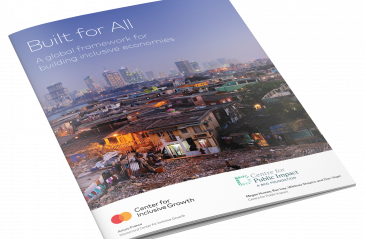
Systemic funding architecture: A proposition to catalyze urban climate finance

There are many possible uses for SIBs in South Africa
Share articleSIBs can promote innovative approaches for high impact service delivery
Share articleSIBs can drive capacity development in a variety of not-for-profit sectors
Share articleWe put our vision for government into practice through learning partner projects that align with our values and help reimagine government so that it works for everyone.
In May 2013, we gave our first presentation on the potential of social impact bonds (SIBs) in South Africa to the Western Cape's provincial government in a fourth-floor boardroom in the Premier's office. In two weeks, the Western Cape Government will publish the specifications for the recently announced commissioning of South Africa's first three SIBs - all within the field of early childhood development. As we celebrate this significant milestone and look forward to their launch in early 2017, people often ask us: what other opportunities exist for SIB mechanisms in South Africa?
The answer is that there are many possible applications and strategic uses for SIB structures, some with relevant initiatives already in development. Unemployment is a long-standing problem in South Africa, affected by students' difficulties in educational access and completion. Pronounced disparities in the quality of primary and high school education are combined with low tertiary participation and completion rates, and these adversely impact the post-educational prospects of many young South Africans.
Elsewhere the country faces a significant burden of disease, including HIV/AIDS and tuberculosis (TB), and the government is continually seeking to improve preventative programmes. These application areas and a number of other policy focal points already attract significant amounts of public funding. However, there is scope for SIBs to crowd in further funding and promote innovative approaches to assuring high impact service delivery.
South African unemployment has hovered around 25% for much of recent history. The South African government spent in excess of R100 billion on employment programmes between 2009 and 2014, but the unemployment rate has still trended upwards over the same time period - reaching a 10-year high in 2016. Research indicates that there are a significant number of jobs that are not filled, due to mismatched skills and a lack of job readiness in the workforce.
This presents opportunities to further innovate around the issue and use outcomes-based contracting and SIBs to support workforce development initiatives. The City of Cape Town is presently working towards an outcomes-based contract to promote work readiness and job placement, which - depending on the investment requirements of the contracted service provider - may well take the form of a SIB.
High unemployment notwithstanding, graduate unemployment in South Africa is less than a third of the general unemployment rate. Consequently, there is also scope to increase employment levels through interventions in higher education. The tertiary sector has been rocked by student fee protests over the course of the last year, which have highlighted the significant inequalities still present in educational access and completion.
There are various solutions currently under exploration to address these issues, and SIBs could well be harnessed to provide funding and support for college and university students. We have been working with a number of public and private sector partners to assess the feasibility of using SIBs and other outcomes-based contracts to improve tertiary outcomes, and these may include measures such as on-time graduation and encouraging students to enrol in scarce skill disciplines.
As a nation we still struggle with the legacy of the HIV/AIDS epidemic, with 12.2% of the population estimated to be HIV-positive. The South African National AIDS Council (SANAC) recently launched a programme targeted at reducing the burden of HIV/AIDs in sex worker populations, as well as promoting access to care for comorbidities, including TB. SANAC is collaborating with Social Finance (UK) to see if part of the funding for this programme can be deployed using an outcomes-based financing mechanism that may take the form of a SIB
Such efforts are interesting from a preventative health standpoint but also open up avenues to promote corporate investment into SIB initiatives. For instance, there is a significant burden of HIV/AIDS and TB within the local mining industry, and TB-related fatalities alone can be several orders of magnitude higher than deaths resulting from on-the-job incidents. SIB initiatives that are able to demonstrate links to workforce protection and productivity or the treatment expenses of key industry segments can play a role in unlocking corporate investment. Opportunities also exist to match prospective increases in SIB investment by using Broad-Based Black Economic Empowerment codes to crowd in more outcomes-based funding in appropriate sectors.
SIBs also have the potential to drive capacity development in a variety of not-for-profit sectors. Government representatives often bemoan the shortage of strong not-for-profits that they can partner with in order to deliver key outcomes, and they show an interest in using SIBs. In such cases, the SIB model can be used as a strategic tool to deliver on these objectives and fast-track the development of entire sectors over time. The model provides the necessary impact measurement and performance management - and the inherent flexibility - to help build service delivery capacity and strengthen related measurement and evaluation systems.
We are excited to see how the market for SIBs and other outcomes-based financing structures progresses in South Africa, and we hope to realise more deals in key policy areas, as well as seeing the impact of more strategic applications over time. Watch this space - you can be sure it won't be another three years until the next tranche of SIBs is announced.












